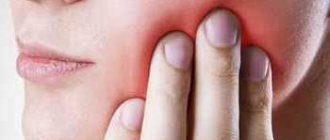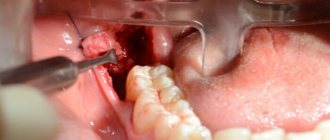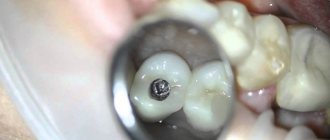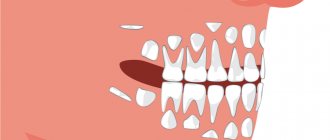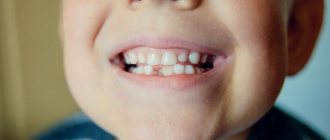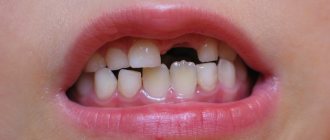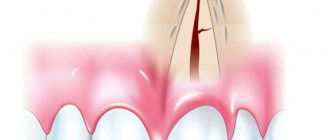Content:
- Should baby teeth be treated?
- The most common dental diseases in childhood
- Treatment of baby teeth
- Anesthesia in pediatric dentistry
- What to do to avoid having to treat baby teeth
Parents often shake their heads negatively when asked whether baby teeth need to be filled. It seems to them that it is not at all necessary to do this, because very soon the temporary bite will be replaced by a permanent one. Dentists categorically disagree with this opinion. Doctors say that you need to take care of the health of your milk units just as thoroughly as your primary ones.
A child’s teeth are crumbling: what is the reason?
When a child’s teeth crumble, especially in young children in the first years of life, the reasons will be somewhat different than in adults:
- The child’s weak immune system, which reduces the body’s resistance to bacterial infections.
- Malocclusion.
- Intrauterine development disorders - usually the causes lie in poor nutrition or bad habits of the mother during pregnancy.
- Genetic predisposition.
- Poor nutrition, consumption of excessive amounts of sweet foods (including juices, sweet teas), night feeding.
- Poor hygiene. Unfortunately, not all parents take care to start brushing their children’s baby teeth on time and do not always teach their child to take care of the oral cavity from an early age.
- Long-term use of pacifiers and pacifiers. Very often, a child’s teeth crumble due to the fact that even with milk teeth already formed, the baby continues to regularly suck nipples and pacifiers, which spoils the bite and leads to the gradual destruction of the enamel.
Should baby teeth be treated?
There are a number of reasons why it is imperative to take care of your child’s baby teeth. Among them:
- Negative changes in the bite in the case of premature destruction of individual teeth, violation of the location of permanent units. Because of this, in adolescence, a child has to wear braces, which cause him a lot of physical inconvenience and psychological complexes.
- The risk of infection transferring from a baby tooth to the permanent bud. These complications are possible with pulpitis, cysts, periodontitis. Bacteria can also penetrate bone tissue, and this is very dangerous for the health of a small patient.
- The development of diseases of the gastrointestinal tract as a result of premature destruction of dental crowns. Then the smile becomes partially toothless and it is difficult for the child to chew food. If large pieces of food enter the stomach, digestive processes worsen and slow down.
- Problems with diction and sound pronunciation. A “toothless” mouth contributes to the development of a lisp. Because of this, the child may be criticized by peers.
Also, when talking about whether it is necessary to treat baby teeth, doctors never tire of reminding them of the pain that a child faces if the dental disease that has arisen progresses. Is it worth exposing your baby to such torture? After all, they can be easily avoided by promptly treating temporary canines, incisors and molars.
Features of the structure of temporary teeth
Parents need to know one simple truth: the earlier teeth are affected by caries, the more severe the consequences will be for the child. In the worst case, with a strong inflammatory process in the baby tooth, the permanent rudiment hiding underneath may even die. That is, the permanent tooth simply will not erupt at the right time!
- Many adults believe that temporary teeth cannot hurt because they do not have nerves. This is a serious misconception.
- The pulp, that is, the neurovascular bundle, is not only present in them, but also occupies most of the volume.
- But the walls of the teeth are distinguished by greater thinness, due to which the resulting carious cavity very quickly leads to inflammation of the nerve - pulpitis.
- The infection then invades the surrounding tissues, leading to the formation of a serious complication, periodontitis. In such cases, the buds of permanent teeth in children may also be involved in the inflammatory process.
The most common dental diseases in childhood
Among the main problems that force children to undergo dental treatment:
- Caries. Children encounter it most often. The disease is found in more than 60% of children under six years of age. It especially often affects molars. This is due to their relief volumetric surface and the baby’s nutritional conditions. On the crown of molars, plaque is deposited more actively. Pathogenic microorganisms multiply in it. The result of their life activity is progressive caries. The difficulty is that in the first stages, parents are not always able to detect a carious cavity on their own. It looks like a light speck and practically merges with the healthy surrounding enamel. Not knowing about the presence of the disease, mothers and fathers postpone a visit to the pediatric dentist. When the child arrives for an appointment, the carious “hollow” already turns out to be very large.
- Periostitis (flux). A complication of advanced caries, caused by the spread of bacteria, damage to tooth roots and tissues adjacent to them. The cheek is swollen. A voluminous abscess forms on the surface of the gum. When palpated, acute pain occurs. Flux may worsen the baby's general condition.
- Periodontitis. Inflammatory periodontal disease. The latter is formed by: periodontal ligament, gums, root cement and alveolar bone. It hurts your baby to bite into hard food. His temperature rises and headaches appear.
All of these dental diseases are highly treatable. The most important thing is not to put off visiting a dental clinic until later.
Invasive treatment of caries
If there is a hole in a tooth, it is treated as if it were permanent, using an invasive method. First, using a drill, the dentist prepares the carious cavity and removes softened, pigmented tissue. Rinses, dries and disinfects the tooth.
After sanitation, a filling is placed inside the cleaned cavity. Today, light-curing filling composites are the most popular. They are applied in layers, and at each stage they are illuminated with a special lamp for curing. Light-curing fillings have good strength, long service life and do not shrink, which reduces the risk of developing recurrent caries under the filling.
After installing the filling, the doctor adjusts it to the bite, grinds and polishes it, giving it the correct anatomical contours.
Treatment of baby teeth
fluoridation
comes to the rescue . The enamel is treated with a fluorine-containing compound. Due to which it becomes stronger, the progression of the carious lesion is inhibited.
Advanced caries, like pulpitis and periodontitis, requires a filling procedure. It is carried out using local anesthetics, so neither the child nor his parents should be afraid of pain or severe discomfort.
When treating the roots of milk units, doctors use a special material, which in the future will be absorbed along with the roots. Thus, the treatment in no way changes the order of tooth replacement.
Regular children's medical examinations are not a whim of dentists, but a necessity
Children's dentists in Moscow recommend bringing your heirs for free medical examinations every 3-4 months to guarantee them a beautiful smile and healthy teeth. If the carious process is not stopped in time:
- a chronic focus of inflammation will appear in the baby’s body, the infection from which can spread to other systems and, in particular, cause severe inflammation of the jaw bone;
- caries that has developed into pulpitis and periodontitis can cause severe pain;
- the rudiments of permanent teeth may suffer or die.
Anesthesia in pediatric dentistry
What type of anesthesia will be used during treatment depends on the degree of advanced disease. Most often, doctors use a spray that makes the gum tissue insensitive.
If the problem is serious, injectable painkillers are used. But so that the little patient does not feel pain during the injection, the doctor first lubricates the area where the needle is inserted with an anesthetic. This approach to pain relief makes even complex dental procedures not at all scary and as comfortable as possible for the little fidget.
General anesthesia in pediatric dentistry is used only for the most severe illnesses or if it is not possible to persuade the patient to open his mouth and sit quietly in a chair. Parents should not be alarmed if the doctor recommends general anesthesia. It involves the use of a modern, safe drug with a minimum number of side effects.
What to do to avoid having to treat baby teeth
In order not to have to wonder whether it is necessary to treat baby teeth, it is necessary to pay maximum attention to preventive measures. These include:
- proper and regular brushing of teeth;
- visiting the dentist twice a year (or more often if the child is prone to dental diseases);
- using a high-quality toothbrush and toothpaste;
- balanced diet, avoiding eating a lot of sweets;
- rinse your mouth after every meal.
If you take care of your teeth, the risk of tooth damage will be much lower. This means that a visit to the dentist will mostly be associated with affordable and absolutely painless prevention.
Why do adults' teeth crumble?
Only a doctor can determine the exact cause of the destruction and increased fragility of dental tissues, so you should immediately contact a dentist as soon as such a problem has been identified. However, there are common reasons for its occurrence:
- Metabolic disorders leading to changes in the acid-base balance in the oral cavity (enzymopathies, inflammatory bowel diseases that lead to metabolic problems, etc.).
- Hormonal imbalances are most often observed in women during pregnancy and menopause, in adolescents during puberty, as well as in people with diseases of the thyroid gland or other organs of the endocrine system.
- Lack of minerals and vitamins. It is often associated with dietary habits, but may also depend on the region of residence (for example, people living in northern regions have more problems with the oral cavity due to a lack of a number of microelements).
- Insufficient or irregular oral hygiene. Poor cleaning of plaque and food debris creates a favorable background for the proliferation of pathogenic microorganisms that cause caries and gradually destroy dental tissue.
- Malocclusion. Very often, the destruction of tooth enamel is caused by an incorrect bite, due to which the dentition does not close as nature intended, and the dental tissues are therefore injured and destroyed.
- Bad habits. Smoking, the habit of chewing hard objects, cracking nuts and seeds, as well as the habit of consuming foods that contrast in temperature at the same time (for example, ice cream and hot coffee) often lead to crumbling of tooth enamel.
- Genetic predisposition.
If an adult’s teeth are crumbling, the cause of this pathology is one of the listed factors. However, only a doctor can determine exactly what affected the dental tissues.

